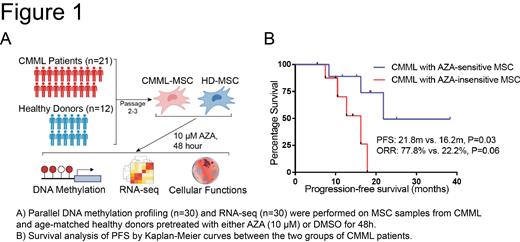Background: Being the most standard first-line treatment option for chronic myelomonocytic leukemia (CMML), the mechanism by which hypomethylating agents exert therapeutic effects has not yet been elucidated. While it was previously believed that HMAs act primarily through inhibiting DNA methyltransferases and restoring the expression of tumour suppressor genes, recent findings suggested its therapeutic effects might involve remodelling the bone marrow mesenchymal niche. Bone marrow mesenchymal stromal cells (MSCs) were hypothesized to play a role in this process. Nevertheless, the lack of evaluations on MSC amenability to HMAs has hindered a complete understanding of the post-HMA treatment mechanisms in patients with CMML.
Aims: The present study aimed to investigate the effects of azacitidine (AZA), the most commonly used HMA, on CMML patient-derived MSCs and to determine its associated clinical significance. The specific aims were to understand the AZA-induced modifications on the DNA methylome/transcriptome and, thus, to evaluate the molecular/functional impacts of AZA treatment on hematopoiesis-supportive functions in MSCs. At last, we attempted to evaluate the association between in vivo/ex vivo sensitivity of MSCs to AZA and post-HMA efficiencies in CMML patients.
Methods: High-throughput multi-omic methods including DNA Methylation Profiling (Infinium HumanMethylation850K BeadChip, Illumina Inc), RNA-sequencing (RNA-seq), and exome sequencing were utilized to assess the regulatory effects of the treatment of AZA (10 μM for 48 hours) on the DNA methylome and transcriptome of CMML patient-derived MSCs. Molecular and functional investigations including DNA damage assessment assay and long-term culture initiating cell (LTC-IC) assay, were performed to validate the sensitivity of CMML patient-derived MSCs (Figure 1A). At last, using univariate survival analysis, we assessed the association between the sensitivity of patient-derived MSCs to AZA and the efficacy of HMA-treated patients.
Results: AZA treatment induced global DNA demethylation in both CMML-MSCs and healthy MSCs, with CMML-MSCs showing a more complex and bidirectional response pattern to AZA than healthy MSCs. The combined multi-omic analysis identified 1395 “AZA-sensitive genes” as potential regulatory targets in CMML-MSCs (66.4% up-regulated and 37.5% down-regulated). These genes were associated with hematopoiesis support, cell adhesion, and immune activation. Functional assays confirmed that AZA restored the expression of hematopoiesis-supportive cytokines and improved the hematopoiesis-supportive abilities of CMML-MSCs. At last, the higher sensitivity of MSCs correlated with a significant superior progression-free survival (PFS; 21.8 months vs. 16.2 months, P=0.03) and higher overall response rate (77.8% vs. 22.2%) in CMML patients treated with at least 2 cycles of HMAs (Figure 1B).
Conclusion: The study provides evidence that patient-derived MSCs are sensitive to AZA treatment at the DNA methylation level, suggesting a modulable bone marrow mesenchymal niche during HMA treatment. AZA treatment rejuvenated functionally defected CMML-MSCs and restored their ability to support normal hematopoiesis in vitro. The sensitivity of CMML-MSCs to HMA correlated with clinical outcomes, with patients having AZA-sensitive MSCs showing superior PFS and higher clinical response rates after HMA treatment. These findings support the theory that AZA may switch the dysfunctional MSCs from a “leukemic-supportive” phenotype to a “hematopoiesis-supportive” phenotype. However, further investigations are required to understand whether this recovery of the hematopoietic niche directly leads to the inhibition of malignant blast cells. Patient-derived xenograft models are recommended to further verify the potential therapeutic effects of HMA-associated modulations on the hematopoietic niche.
Disclosures
No relevant conflicts of interest to declare.


This feature is available to Subscribers Only
Sign In or Create an Account Close Modal